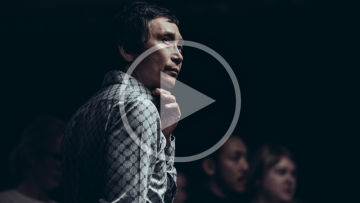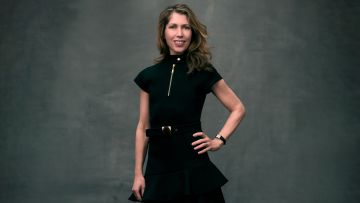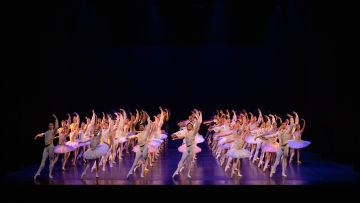Q&A with Company and Academy Strength Coach Tony Lewis

Curiosity, competitiveness, and kindness are just a few of the traits Tony Lewis lives by. From a sports-loving kid in rural Queensland to a Principal Dancer performing roles across Europe and Australia, Tony now combines his love of ballet, sport science, and health in his role as Strength Coach at Queensland Ballet Academy and the Company. Here, he shares insight into his inspiring journey to the top of his game.
How did a sports-obsessed young boy from Ayr in regional Queensland discover a passion for ballet?
Ayr was very much a sporting town when I lived there and dance wasn’t really on the cards for boys, so I played sports all the way through until I left: soccer, gymnastics, golf, rugby league or whatever was being played at the time of year. I suppose I was one of those kids that did well in whatever sport I chose.
I found dance about a month before my 16th birthday. I had been doing karate and had noticed a guy I was training with was really improving. I asked him what secret training he was doing, and it was a jazz and limber class – it was the mid-80’s. So, we’d finish karate and then go to dance class, and eventually my mother and dancer teacher decided they should get me doing ballet lessons.
What happened next?
To be honest, I was reluctant! Probably like most young men at the time, I had a falsely perceived idea of boys in ballet, but my mother said to me ‘just go along, do one class and if you don’t like it, then that’s fine’. So I went, and I had a male teacher from Townsville, and the class challenged me like I’d never been challenged before. And the appeal then was, I couldn’t see an end point. With other sporting teams I’d played with you could make a national team and that was about it, but with ballet I couldn’t see where it stopped and that really interested me – at how far it could go.
What was the reaction from your friends, family, and town?
I don’t know whether I was fortunate to have a good group of friends that were happy for anyone to go off and do what they wanted to do, or whether it was because of my sporting background, but there was no hostility or bullying or anything like that. But I was probably always pretty focused on me, and I didn’t pay too much attention to what was happening around me.
From rural classes to The Australian Ballet and touring Europe?
After about a year of dancing in Ayr, I auditioned for the Australian Ballet School. Dame Margaret Scott took the audition in Townsville, and she singled me out of the group. I didn’t know what half the steps were called, and she was having to get up and show me things. She called myself and my parents in afterwards and said ‘look, he’s not ready for the Australian Ballet School but I want him to go to the National Theatre Ballet School’. So I graduated high school, moved to Melbourne and spent a year there, and went to the Australian Ballet School after that.
From there, I was offered a six-month contract performing in The Australian Ballet’s Spartacus, and there may have been the possibility to have stayed with them, but I had a desire to go to Europe. I spent three years living in Europe – Germany, Switzerland – and loved it. They were some of the happiest times of my life.
When did you join Queensland Ballet?
I was in Europe in 1993 when I received a phone call in the wee hours in the morning from Harold Collins (Queensland Ballet’s Artistic Director from 1978-1997). He was offering me a position here. I pretty much got the job unseen – the power of reputation! So, I walked into this building – the Thomas Dixon Centre in 1993. We used to dance on the original floorboards with just Tarkett laid over the top. I spent 10 and a half years with the Company, and retired as a Principal Dancer at the end of 2003, with François Klaus as Artistic Director.
Tell us about your journey from Principal Artist to Strength and Conditioning Coach.
In 2002, I ruptured the Anterior Cruciate Ligament in my right knee, which put me out for a year. While I was going through rehab, I became really interested in what the physiotherapists were getting me to do, so much so that I ended up doing a Certificate 3, then 4, then other qualifications after that. After I retired, the owner of my gym offered me a job. I walked out of Queensland Ballet, from starting work at 10am in the morning, to starting work at 5.30am at the gym, which was a massive shock (laughs). It was a pretty smooth transition other than that, and I’ve just continued to learn ever since. I have my own private clients, who are a mixture of mums and dads, and other athletes – tennis, golf, football, soccer, triathletes, and I also work at Queensland Ballet Academy and Company.
What do you enjoy about working with dancers?
At the Academy I like that I’m working with the future. I look at these students that are the same age as I was when I began dancing, and they are far better than I was, so I’m always fascinated by how much they’ve evolved. And how do we make these dancers better than the dancers that are around now? I really enjoy that challenge.
I also enjoy the people. Dancers are a special breed, and I love it when they get excited when something finally clicks, because they’re so in tune with their bodies, they feel it, and they know it. I get a real kick out of that. Sometimes I’ll watch class and had been working on something with one of the dancers, and all of a sudden – you see it happen – it might be a jump and it suddenly comes together and they’ll stop and turn and look straight across at me and that’s great. I’ve only played a very small part in what’s happened, but it’s really satisfying.
How does your role at the Academy differ to the work you do with the Company?
I see my role within the Academy as their strength coach, but also as a bit of a mentor. I try to put myself in their shoes and think back to what it was like when I was at high school and learning dance, and dealing with the pressures of exams and school and ballet, along with everything else. Hopefully I give little bits of help and advice and it helps to get them through it. From a strength and conditioning point of view, you can usually see a link between how someone is performing in the gym as to whether there’s something else going on, and if that’s the case I can raise it with the staff and health team.
After such a successful career as a dancer and beyond, what advice would you give to the next generation of dancers?
Any advice has to be based on your own development and career, but for me it was always about being curious – listening with my own ears, watching with my own eyes.
Another one is to be kind. After performances, my wife and I would always thank the support staff for their contribution – stage manager, crew, orchestra, and everyone. It makes the journey a bit easier.
Then there’s focus; you’ll always go through ups and downs, there’ll be numerous distractions, you’re going to have days where you’re working really hard and not getting anywhere. But I think, for me, probably what sport taught me was – eyes on the prize.
Be a teacher. Once you’re into your career, pass the knowledge on, work with the younger dancers. It’s amazing what you hear yourself say, then you can apply that to yourself. Way back in 1994 until 1999, myself, my wife Victoria Hollyman (former Queensland Ballet Principal Dancer), and Shane Weatherby (former Queensland Ballet Principal Dancer) taught a summer school at Queensland Ballet, and I’d walk away from those summer schools with a notebook full of notes for myself to apply in my own world.
And finally, start a qualification while you’re in the early stages of your career. Even if you do one or two subjects per semester, just do something before you really start getting busy as a soloist or principal artist so that when you retire you can continue with a postgraduate degree or similar. I was 35 and a half when I retired… but I suppose if happiness is success, I’m happy with where I am. And for me – I often say to Zara Gomes (Queensland Ballet Head of Performance Health) if I could be here all the time doing what I do I’d be the happiest person alive. This is my happy place.
By Cassandra Houghton



